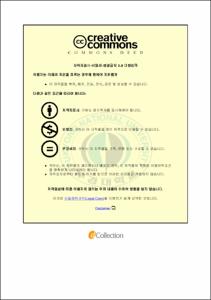수열합성법을 이용한 금속이 치환된 M-BiVO4의 제조 및 특성에 관한 연구
- Abstract
- Thermochromic characteristics of monoclinic crystalline bismuth vanadate (BiVO4) were bright yellow pigment with good gloss and hiding powers The important characteristics of BiVO4 were heating temperature and clear color change. In this experiment, BiVO4 powders were prepared from a mixed aqueous solution of bismuth nitrate (Bi(NO3)3) and ammonium vanadate (NH4VO3) with different temperatures by one-step hydrothermal method. Monoclinic crystalline BiVO4 powders could be obtained in low reaction temperature. We used the metal (magnesium and copper) as dopant during the synthesis of BiVO4 powders in order to obtain clear color change of thermochromic behavior. The crystallinity, optical properties, Thermochromicanalysis and morphology of samples were characteristics by the means of X-ray diffraction (XRD), scanning electron microscopy (SEM), Fourier transform infrared (FT-IR), UV-Vis spectrophotometer (UV-Vis), differential scanning calorimetry (DSC), and color difference meter.
- Issued Date
- 2015
- Awarded Date
- 2015. 2
- Type
- Dissertation
- Publisher
- 부경대학교
- Affiliation
- 공업화학과
- Department
- 대학원 공업화학과
- Advisor
- 박성수
- Table Of Contents
- Contents
Contents.....................................................................................................................ⅰ
List of Figures..........................................................................................................ⅲ
List of Tables...........................................................................................................ⅵ
Abstract......................................................................................................................ⅶ
제 1 장. 서론............................................................................................................1
제 2 장. 이론적 배경..............................................................................................3
2-1. 열변색...............................................................................................................3
2 2-1-1. 열변색 원리................................................................................................5
2 2-1-2. 열변색 재료................................................................................................6
2-1-2-1. 가역적인 열변색 재료............................................................................6
2-1-2-2. 비가역적인 열변색 재료........................................................................8
2 2-1-3. 열변색 재료 응용......................................................................................9
2-2. Bismuth Vanadate..........................................................................................12
2 2-2-1. BiVO4의 결정상 특성.............................................................................12
2-2-2. BiVO4의 열변색 특성.............................................................................15
2 2-2-3. BiVO4의 상전이 특성.............................................................................17
2 2-2-4. BiVO4의 응용...........................................................................................19
2-3. 합성법의 종류...............................................................................................21
2-3-1. 액체 침전법..............................................................................................21
2-2-3-2. 고상법........................................................................................................23
2-2-3-3. 줄-겔법.......................................................................................................25
2-2-3-4. 수열합성법................................................................................................27
제 3 장. 합성 및 분석..........................................................................................29
3-1. 출발물질.........................................................................................................29
3-2. 합성 과정.......................................................................................................30
3-3. 분석.................................................................................................................31
- 3-3-1. XRD 분석..................................................................................................31
- 3-3-2. SEM 분석..................................................................................................31
3-3-3. FT-IR 분석................................................................................................32
3-3-4. UV/Vis/NIR분석.......................................................................................32
- 3-3-5. DSC 분석..................................................................................................33
3-3-6. 색차계분석................................................................................................33
제 4 장. 결과 및 고찰..........................................................................................34
4-1. 결정상 특성.....................................................................................................34
4-2. 입자형태 특성.................................................................................................41
4-3. 분광학적 특성.................................................................................................46
4-4. 열변색 특성.....................................................................................................49
제 5 장. 결 론........................................................................................................53
참 고 문 헌.............................................................................................................54
- Degree
- Master
- Files in This Item:
-
-
Download
 수열합성법을 이용한 금속이 치환된 M-BiVO4의 제조 및 특성에 관한 연구.pdf
기타 데이터 / 1.57 MB / Adobe PDF
수열합성법을 이용한 금속이 치환된 M-BiVO4의 제조 및 특성에 관한 연구.pdf
기타 데이터 / 1.57 MB / Adobe PDF
-
Items in Repository are protected by copyright, with all rights reserved, unless otherwise indicated.